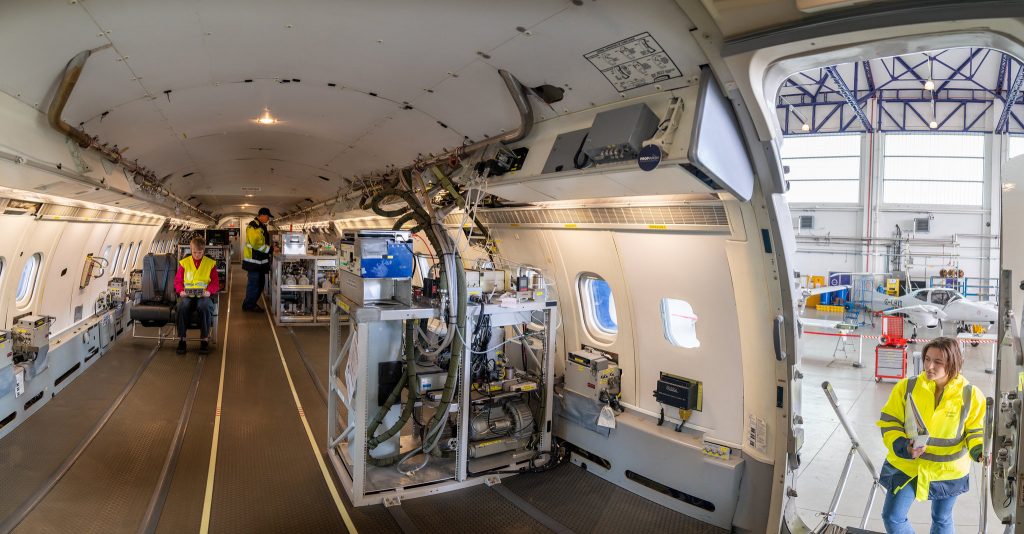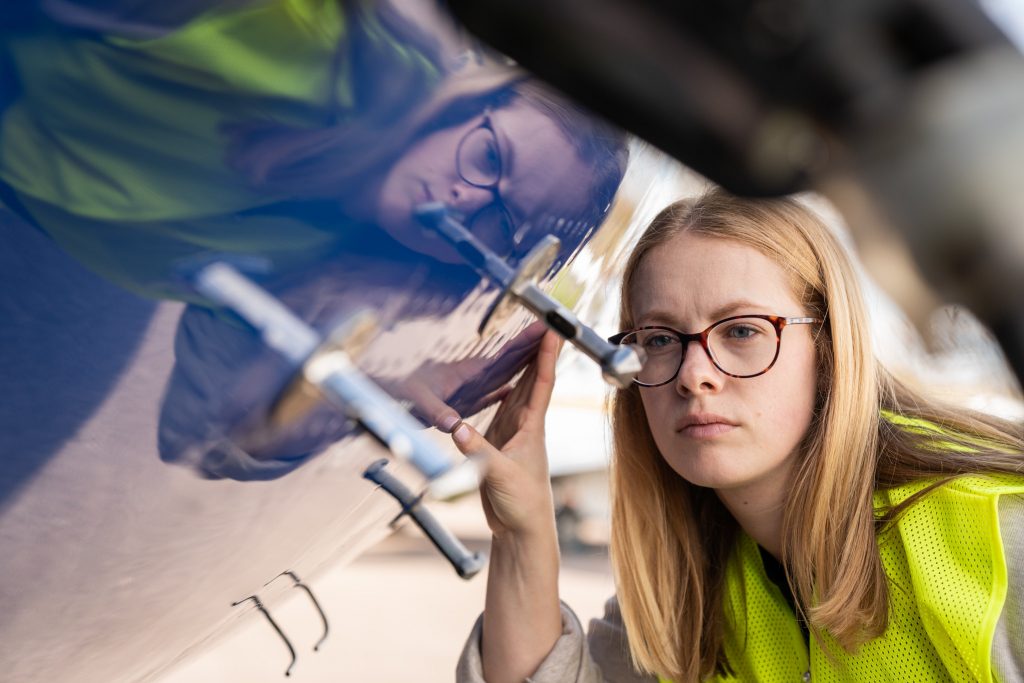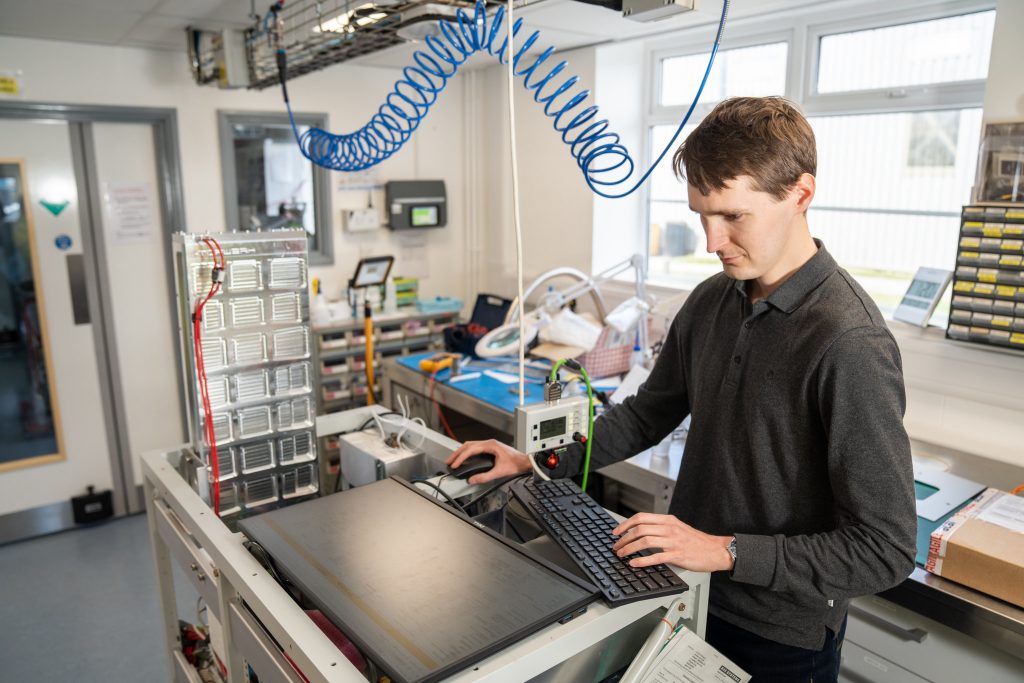Working with the FAAM Airborne Laboratory, engineers are scoping out how airborne atmospheric science missions could be crewed in the future.

Who flies on our research aircraft?
Every time the FAAM Airborne Laboratory’s research aircraft flies, its suite of scientific instruments are crewed by an expert team. The team includes up to 21 data and mission specialists, supported by a smaller team of 3 or 4 ground-based operations managers – together they manage the equipment, monitor the data being collected in real-time, and share information to safely fly the planned science mission.
A lot of information-sharing happens via satellite communications technology, or SATCOM. At the moment, most communication between scientists on board the aircraft and our operations team on the ground happens via an instant-messaging chat function. Upgrading our SATCOM systems might allow us to introduce voice communications or send more information between the aircraft and the ground.
How could new technology change our science missions?
As part of our Mid-Life Upgrade programme, we are upgrading our scientific instruments to enable researchers to collect higher-quality and more accurate data.
Our engineers are sourcing newer and more reliable parts to help keep faults and downtime (periods where the aircraft cannot fly) to a minimum. Smaller and lighter scientific instruments, and infrastructure that supports measurement-making, can be made with new materials and electronics technology.
Automation will also support us to regulate our instruments better, giving crew members more time to focus on the science aims of a flying campaign. Incorporating this automation technology will require learning how to work with new instrument technology safely and effectively.
Mid-Life Upgrade Director, Steve Devereau, adds: “via the MLU, it is intended that we can network the aircraft to NCAS’s computing systems at all times, for example when the aircraft is being prepared for flight at Cranfield, or in the hangar for maintenance, or at a forward operating base on detachment, or in flight. This allows scientists and engineers the opportunity to test and develop our scientific instrumentation. This also allows computer models to be run on the ground to provide real-time information to the aircraft and vice versa.”

Why do we want to be able to remotely operate our equipment?
Remote operation and automation technologies are already in use across the aviation and space science sectors. Adapting to, and training for, these changing technologies is something we need to do as they become more easily-available.
As instrument technology improves, we will require fewer people physically onboard the research aircraft to operate the instruments. Similar to the phasing out of flight engineers on passenger airline flights, new technology reduces the need for manual switch-flicking and button-pushing.
There are many practical reasons why we would want this: reduced project costs, lower emissions associated with sending crews on a mission, less time separated from friends and family, and greater operational flexibility coming from the new weight and space available for science.
How would we make remote operation work?
Remote operation will not mean cutting back our crews entirely.
In future, we could work with a reduced team of instrument scientists onboard – to do flight checks and operate all of the instruments. Other crew members could transition to data monitoring roles at ground-based stations.
This offers a big advantage – we will be able to access a more diverse set of skills and knowledge across the scientific community, as people who were unable to be an airborne crew member will be able to take part in ground-operated data collection.
We can learn from aircraft flight testing or spaceflight missions, which often operate with teams of people far in excess of their cabin capacity. These offer guidance on safe and effective hybrid crew operations. It is important to us that crews feel like they are one cohesive unit, on the same mission, seeing the same information, and able to communicate clearly.
Through the Mid-Life Upgrade we have been working with the Centre for Aeronautics at Cranfield University to determine how we might bring automation and remote operation to the FAAM Airborne Laboratory. Although the FAAM Airborne Laboratory has used SATCOM in its operations since our BAe 146-301 Atmospheric Research Aircraft first flew in 2004, the Mid-Life Upgrade could see this capability taken to a new level.

Colleagues at Cranfield University’s National Flying Laboratory Centre have implemented a hybrid data-streaming capability in their flying classroom. This helps to check equipment and teams can work together cohesively, before all of the eventual equipment is designed and fitted to an aircraft. For the FAAM Airborne Laboratory, when we design a new instrument in the future, we are not only looking at how we can work with it but also how it can work with decision-making from the ground.
While many of our instruments need monitoring and adjusting in-flight, we may not need a bespoke SATCOM system for a ground-based team to be able to communicate with instrument operators aboard the aircraft. It is likely that our requirements could be met by off-the-shelf solutions that exist in the industry, offering cost and operational benefits.
Future work will look into how we can train our ground-based and aircraft-based crews to work most effectively with each other.
